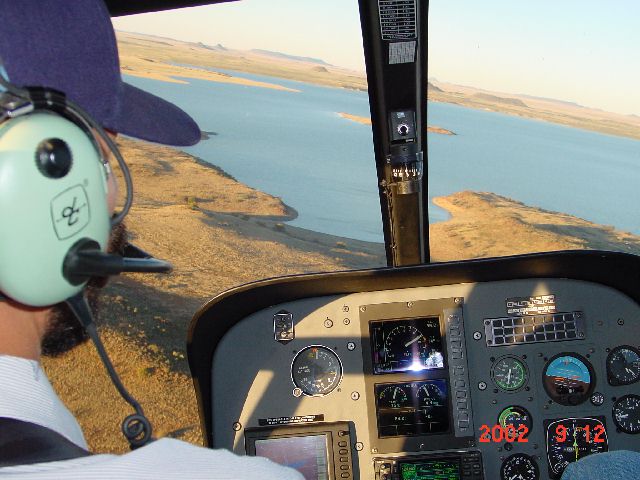
Last updated 2024-12-13
I started flying in 1982, and with a few interruptions have flown fairly regularly ever since.
I now hold a South African Airline Transport Pilot Licence, with a Grade I Instructor's Rating. The licence includes instrument and multi-engine privileges. For about 20 years, I was also a Designated Flight Examiner, Class 1, authorised to issue and renew any aeroplane licence and rating on behalf of the South African Civil Aviation Authority. I also hold a South African Commercial Pilot Licence and Grade II Instructor's Rating on helicopters, although I relatively seldom have the opportunity to fly this category of aircraft. I'm a Class 2 Test Pilot on both aeroplanes and helicopters. I am also a pilot and assistant instructor on gliders and a Grade A instructor on touring motor gliders. Since 2019, I've been flying hot air balloons too, with a Free Balloon Pilot Licence. There is no instructor rating on this licence, but I have accumulated enough experience to start instructing on balloons and managed to get approved by both balloon flying schools.
I also hold a modest collection of certificates in the USA, including an ATP with G1159 and HS125 type ratings and a CFII (ASE/AME/Instrument/Glider). The ratings include Airplane Single and Multi Engine Land and Sea, gliders, helicopters, lighter-than-air and small Unmanned Aircraft Systems.
During 2001, I completed a business degree (BCom) in which I specialised in aviation management. The course work included a lot of industrial psychology dealing with flightdeck management and user interfaces. Airline types know the former as CRM. Everyone knows the latter as ergonomics.
Because I've never been a full time pilot, I have only about 6600 flying hours in my log. However, I've flown over 200 aircraft models, including 13 helicopter models, 20 glider models and 13 hot air balloon models. I have instruction experience on over 135 of those models. Some of the more interesting models include the Beech King Air 90 and 200, the Cessna Citation 500 and 550, the Hawker HS125, the Gulfstream II and III, the Eurocopter 120B and Gazelle, the Bell JetRanger and the Hughes 500. A 2023 addition was a dream come true—the Bell 222. This model had been on my wish list ever since the days of Airwolf in the Eighties! Perhaps the most fun to fly is the Robinson R22, although it also has the potential to bite the unwary at a bewildering rate. High-performance gliders are also wonderful to fly. I occasionally fly a Libelle 201 and once had the opportunity to toss a Jonker JS1 around the sky. Should I mention that the least fun to fly was a specific locally-assembled CH701 Skyjeep?
In my youth, I applied to several airlines, but most of them seemed to feel that my part-time hours did not match my age. I pursued an engineering career instead. In the end, despite holding down a real job, I got the opportunity to fly some pretty exciting stuff. Over 1800 hours of my flying has been in jets. I've subsequently realised that I had a narrow escape—I would have had a hard time coping with the repetitive nature of airline flying.
During 2002, I flew more than usual, as a bout of unemployment forced me to do whatever I could to pay the bills—even helicopter flying! The picture shows me in the office, over the Free State plains in an EC120B. The picture was taken from the back seat by my friend Bernie van der Walt. The EC120B is a new-technology machine, and is indicating over 120 knots at an altitude of over 4000 feet (1300 m). Those who know helicopters will agree that these figures are not too shabby.

During my compulsory military service in the Eighties, I was trained as Air Traffic Controller in the South African Air Force. It was interesting to learn how the other half lives! Contrary to popular belief, my ATC job was the least stressful I've ever held. It did indeed sometimes get hectic. However, clearly the system is designed to prevent overloading any specific individual, so the pressure can never become too much to bear. Also, when one goes off duty, it's all over. One can't take work home! In case you're wondering: I was stationed at an Air Force base that was home to squadrons with at least ten aircraft types. At the time, in terms of movements, this base was the busiest in the country. For a single controller to handle 150 movements an hour was not uncommon. So: I like to think that I am qualified to venture an opinion on ATC stress levels.
Given South Africa's tumultous recent past, I felt for some time that I wanted to make a contribution to maintaining law and order. In 1999, I found an avenue to do that. I rejoined the South African Air Force as a pilot on 111 Reserve Squadron. The Squadron is involved in reconnaissance and transport sorties. For some years, I was the Squadron's training officer, with the rank of Major. I often flew VIP transport sorties in jet aircraft, mostly Hawker and Gulfstream. I covered Africa extensively, regularly visiting almost all countries south of the Equator and a few further north. The Reserves are currently dormant and a resurrection is looking increasingly unlikely.
The picture shows two of the jets I regularly flew, on a fly-by at the 2007 Air Force Day parade. The leading aircraft is ZS-OIF, a Hawker HS125-F400A, in which I did some very satisfying flights. The longest have been to Mahe in the Seychelles and to Lagos in Nigeria, both on civilian medical evacuations. The one closest to the camera is ZS-PFG, a Citation 500 Eagle in which I presented my first jet type rating training course. I also did my first trans-equatorial flight as captain in this jet, to Bangui in the Central African Republic.
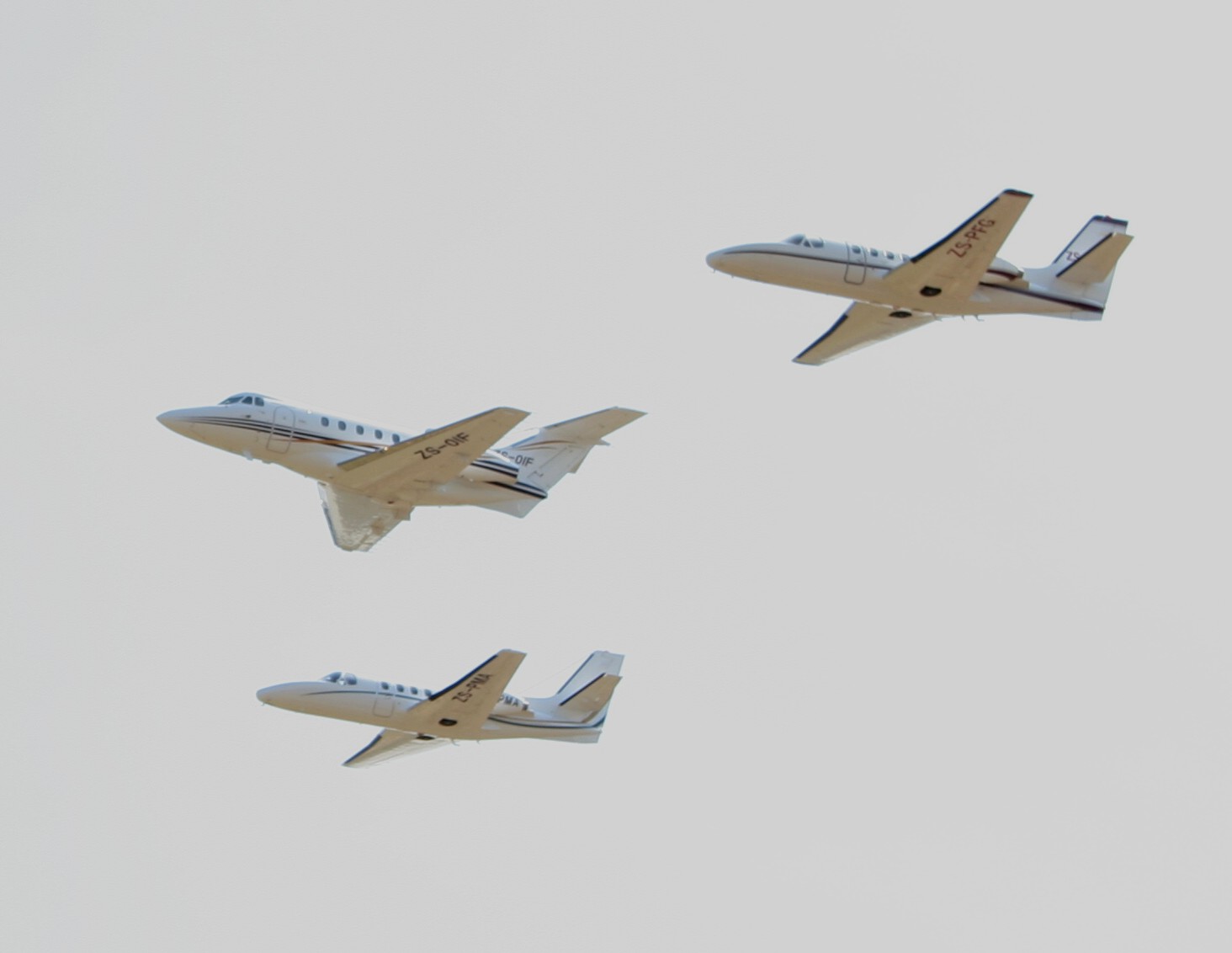
One of my few long-standing ambitions in flying was to cross the Atlantic as pilot. I had visions of removed seats, ferry tanks and wearing a lifejacket in the pilot seat during a 20-hour crossing. In early 2010, I had the opportunity to ferry a Gulfstream III (N554HD, now ZS-VIP) across the Atlantic. I flew as co-pilot while we made our way home in leisurely fashion—four legs over three days. Somehow, flying a powerful bizjet across the ocean in five hours is so much more civilised...
I subsequently had an equally exciting opportunity to ferry a Gulfstream II to a boneyard in California. It's a long way (around 16 000 km!). I stayed in California for less than eight hours, immediately returing to South Africa on airlines. Over 30 hours in the seat over four days and transiting nine time zones each way left me so stiff that I was barely able to walk. It wasn't good timing. Two days after returning, I had to run a marathon to qualify for the Comrades ultramarathon. Suffice to say that it was an exciting but tough week.
My most spectacular trip was also in a Gulfstream, crossing Africa at night and flying the entire length of the Nile valley in crystal clear conditions. We then crossed the Mediterranean into Turkey, then flew to Algeria, before returning home. This trip literally drove me to poetry. I'd always wanted to write a classic Shakesperean sonnet, and here I finally had my inspiration!
My greatest flying adventure happened in 2015, when I had the opportunity to drive a 1944 Grumman G21 Goose in Alaska. The story was published in World Airnews, October 2015. Before this flight, I spent some time in Florida getting my FAA multi-engine seaplane and helicopter ratings. Afterwards, I made the pilgrimage to the world's largest airshow at Oshkosh. The highlight was the Apollo 13 reunion, with Jim Lovell and Fred Haise on stage with two of the mission controllers from that monumental mission.
Most of my more recent flying was in ambulance jets, traversing Africa to collect patients in a mobile intensive-care unit. Interestingly, ZS-OIF is one of the jets that I flew most regularly. Since I first flew 'OIF in 2006, it just refused to leave my life! In the final years before The Flu put paid to my ambulance flying, 'OIF sported a funky paint job branding it as an "Air Ambulance". Unfortunately, The Flu of 2020 put an end to my ambulance flying. It was great while it lasted.
In 2017, long-time buddy Louw van Zyl talked me into some gliding. For the first time, I've been able to do some recreational flying, with no objective but to enjoy the experience and learn. I've learned a lot, but I'm probably still the slowest pilot in the universe. It's amazing to me how one can stay up for many hours, burning no fuel and making almost no noise. With the glider in trim, the experience is completely effortless, and I can sit and look out across the countryside, sporting an insane grin. You can see a few of my flights here. I'm hoping the collection will grow. In the mean time, you can read about my most exciting glider flight. I stayed up for over six hours, having burned less than two litres of fuel to get airborne.
During 2018, I visited the USA to learn more about glider instruction. I spent some time learning from Soaring Hall of Fame member Tom Knauff, did some great soaring on the Appalachian ridge and flew into First Flight Airport, the site of the first flights by the Wright Brothers. I returned with a Commercial glider certificate and instructor rating, and some great ideas on glider instruction. Suffice to say that these ideas are not all common knowledge in these parts.
2021 introduced a new era in my flying career. Six of us have bought a Blanik Vivat motor glider, opening the door to some great soaring and some great training. I was hoping to help my partners to discover new horizons (sic). Unfortunately, reality has been a lot less thrilling.
I don't know if it was the heady experience of the motor glider that destroyed my last remaining restraint, but in 2022 I bought a hot air balloon. The picture shows it during the pre-purchase evaluation. Balloon flying is a completely different experience—serenely floating through the air in complete silence, with only the occasional burner noise.
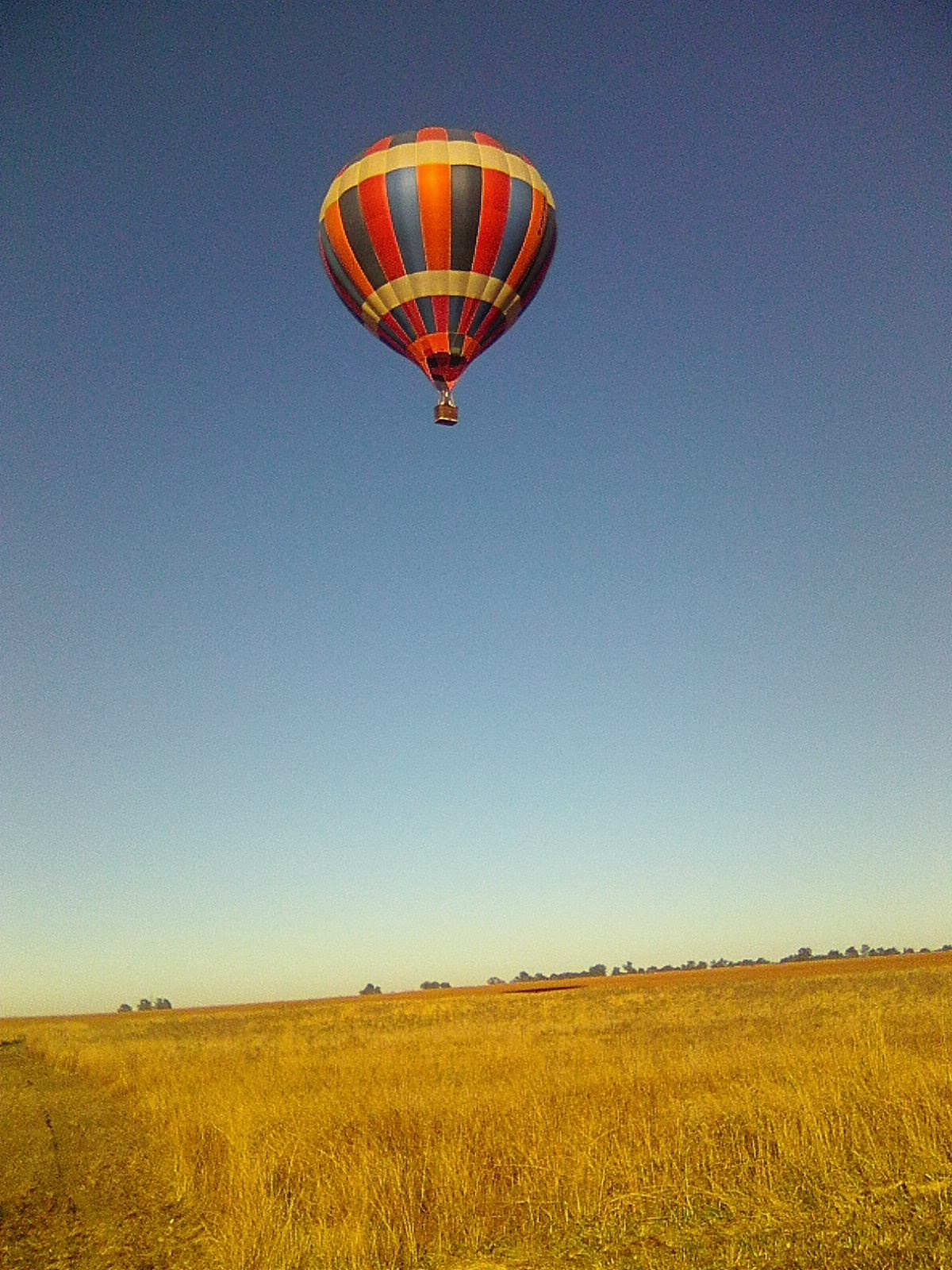
This particular balloon has an illustrious past as a flying billboard. Unfortunately, it became a victim of crime during 2023. Someone hitched the trailer and disappeared, presumably ditching the balloon and illicitly selling the trailer.
During 2024, I finally managed to replace the balloon. The new model is somewhat larger (AX10 rather than AX8), allowing me to accumulate some experience in larger balloons. Here it is, on its airworthiness proving flight.
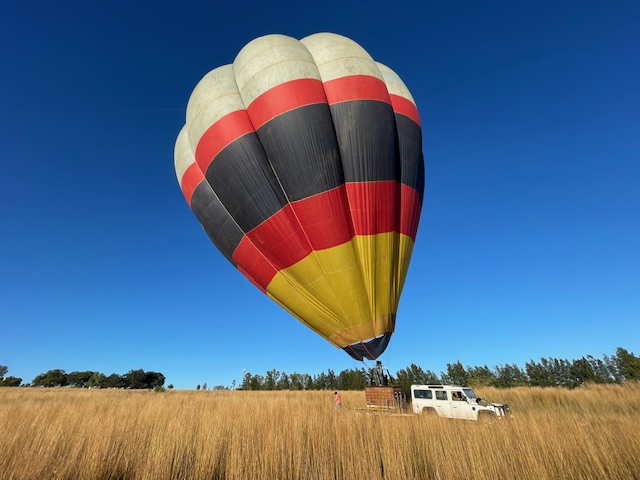
To enable me to provide some training on balloons, I also bought a share in Balloon Training School, one of only two flight schools authorised to provide balloon training in South Africa. Interestingly, my shares formerly belonged to Bill Harrop, a pioneer in the South African balloon industry who died during The Flu. I'm hoping to do some commercial flying for Bill's old company "real soon now".
I became a flight instructor as a means of getting other people to pay for my part-time flying. However, I soon caught the bug and have found my instruction to be a major source of meaning in my flying.
For almost 40 years, I have been giving part-time flight instruction at a number of local airports. Because I have always had a real job outside of aviation, much of the training has taken place at night. I've helped many pilots with advanced training, including night and instrument flying, multi-engine ratings and preparation for Commercial and Airline Transport Pilot licence flight tests. Because I've flown a few weird and wonderful aircraft models, I also provide occasional type-specific training.
2007 saw a breakthrough when I managed to present my first jet type rating course. From 2008 to The Flu in 2020, I was involved in regular training and ongoing licence testing on large jets, as a Class 1 Designated Flight Examiner for South Africa's Civil Aviation Authority. I must admit that I had no inkling when I decided not to become a full-time professional pilot that I would ever fly jets, much less that I would ever provide hundreds of hours of training, helping others learn to fly them!
Towards the end of 2003, I started a flying school at Kitty Hawk airfield just east of Pretoria. Although Superb Flight Training continued to exist in name, I am no longer involved in any way. I ran the flying school for about 13 years, personally supervising over 10 000 hours of flight training. Although the strains of running and funding a company part-time were demanding, the results of all that training proved very gratifying.
After I became an examiner, I started concentrating on instructor training. I am convinced that instructor training is the most efficient way of sharing my experience with other pilots. Every hour I spend with a would-be instructor can be multiplied many times over. This point was brought home once when I met a jet training captain for a local airline, who had been trained by one of my instructors in my flying school, both initially in light aircraft and later in passenger jets.
The Flu resulted in an interruption to my flying. Only in 2024 did I manage to resume regular flight training. Due to my lack of ongoing experience, I allowed my examiner appointment to lapse. I'm now trying to regain it—not a trivial undertaking.
My first book, What to do in an Aircraft Cockpit, is available in English and Afrikaans (as "In 'n Vliegtuigstuurkajuit") and is already in its third printing. It was also published in the USA by ASA as Cockpit Procedures: Effective Routines for Pilots and Virtual Aviators, and is available from many pilot shops and about 150 bookshops on the Web.
Wanting to be a pilot is a genetic thing. I can recall day-dreaming about flying even before I went to school, although I never realised that mere mortals could learn to fly just for fun. I thought one had to pursue a career as a pilot to get access to these amazing machines.
I never flew in a light aircraft until my first flying lesson in 1982. However, I recently came across evidence that I'd at least been exposed to aircraft much earlier, as this picture from circa 1974 shows:

The aircraft is a Mirage F1AZ, a ground attack version of the aircraft that held its own even into the Nineties, when the Iraqi Air Force used them in the Gulf war.
Some of my fondest memories of flying are from 1988. At the time, I had just completed my compulsory military service, and had a government subsidy to allow me to complete my helicopter training. For about six weeks, I had nothing to do but fly a helicopter around the countryside. I spent some time in the Drakensberg and on the coast near Durban, honing my skills and enjoying nature. I even managed to do some gliding in the mountains. Few things can compare with landing on a mountain summit and gazing down into the valley 2 km below for an hour or two, while nibbling at a lunch pack and sipping ice-cold fruit juice. Mountaineers do not always enjoy the sight of a fresh-looking helicopter pilot in a neatly-pressed office uniform awaiting them on the mountaintop...
My timing was impeccable. Within weeks of my return, the Helicopter Association of South Africa organised its first national helicopter competition. With the late airline pilot and helicopter instructor Glen Dell in the left seat, holding the bucket and giving me directions, we won both heats hands-down, and were asked to do a display at the Star Airshow in September 1988.
At the airshow, I did a routine with a water bucket suspended on a long rope below the helicopter. The routine included having to manoeuvre the bucket through an obstacle course and then placing it on a table. The sequence was timed, and the amount of water remaining in the bucket was measured to determine one's performance. After I'd completed the sequence, again with Glen Dell watching the bucket and issuing directions, the chief flying instructor of the helicopter school followed in a second helicopter to do the same sequence. Unfortunately for him, he managed to get the bucket into oscillation, spilling all the water and not getting the bucket through the obstacle course in time.
With a crowd of 75 000 in attendance, I had no way of knowing that my parents had decided to come and watch. Only later did I learn that they were standing in the crowd. The announcer did mention the names of the pilots on the PA system, but didn't mention who was flying which helicopter. At the distance, my parents could not distinguish my face. Imagine my indignation when I discovered that, after watching the first pilot zooming through the course and the second not quite making the grade, my mother had turned to my father and said: "Don't worry, he's only been flying choppers for a few months. He'll get better"!
Glen Dell, who was mentioned before as being my eyes and ears in the left seat during this escapade, subsequently went on to greater things, winning a number of South African aerobatics titles and later the World Advanced Aerobatics title and becoming the first Southern Hemisphere competitor in the Red Bull Air Race series. Glen was killed in an airshow crash in 2014.
For a decade, I did virtually no helicopter flying, but when I returned to it in 2002, I found that the basics were still in place. Given how hard it had been for me to learn to fly helicopters initially, it's amazing that my brain had retained the ability almost undiminished. Even mountain flying and limited-power operations still appeared to work like in days gone by. The picture shows ZS-ROJ, a Eurocopter 120B Colibri coming into the hover over a pad on the edge of a 300 m cliff. We were servicing a mountaintop repeater in the western foothills of the Drakensberg.
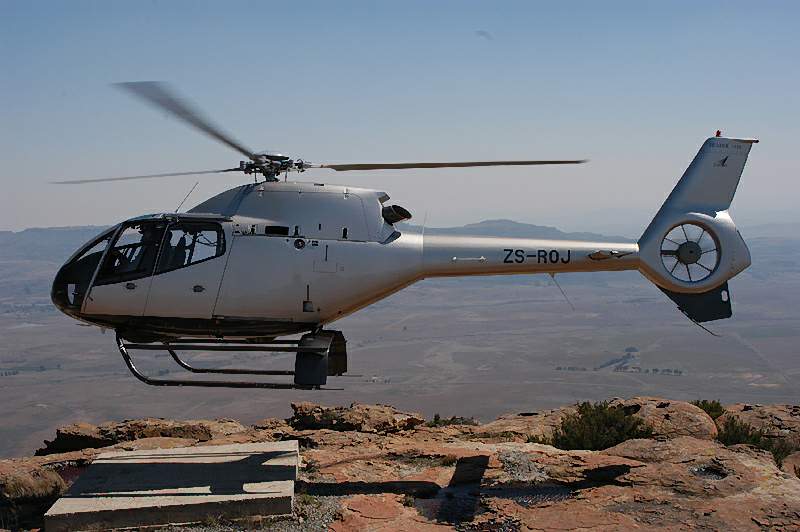
My next opportunity to fly helicopters reasonably regularly came in 2020. Again, the skills returned fairly quickly, against the background of meticulous theoretical preparation. Amazingly, the Gazelle helicopter involved was registered ZU-ROJ, almost the same as the previous one. Sadly, ZU-ROJ came to grief in Mozambique just a few weeks later at the hands of Islamic militants. Nevertheless, I think back fondly to it, and this picture remained on the desktops of all my computers for several years.

I changed my desktop in 2023, when I completed my multi-engine helicopter training in a Bell 222. My desktop now sports the very 222 that I flew. It is an air ambulance, part of Henley Air's world-biggest fleet of 222s and 230s.
Perhaps the fact that helicopter flying appeals to me as much as it does is a matter of personality, as this famous quote from the Vietnam war suggests:
"The thing is, helicopters are different from planes. An airplane by its nature wants to fly, and if not interfered with too strongly by unusual events or by a deliberately incompetent pilot, it will fly. A helicopter does not want to fly. It is maintained in the air by a variety of forces and controls working in opposition to each other, and if there is any disturbance in this delicate balance the helicopter stops flying; immediately and disastrously. There is no such thing as a gliding helicopter.
"This is why being a helicopter pilot is so different from being an airplane pilot, and why in generality, airplane pilots are open, clear-eyed, buoyant extroverts and helicopter pilots are brooding introspective anticipators of trouble. They know if something bad has not happened it is about to." —Harry Reasoner, 1971.
There is an alternative explanation, though. The LMF Theory was only recently declassified. It provides a convincing psychological model to explain why some fly choppers and some don't.
I flew the State President's Trophy Air Race in 1988, along with navigator Martin Scharf and with technical support from Peter Clark. We flew a Beech Baron B55, and placed in the top fifth of the field on our first attempt. The race was unforgettable, especially the last few minutes. Ours was one of several dozen aircraft, screaming down on the finish line after having crossed the mountain some minutes before. We had several thousand feet to lose, and the finish line was in sight. It felt like a Battle of Britain movie, except that all those aircraft were fortunately flying in the same direction. Ours was one of the fastest aircraft in the field, so we took off in second last position. In the furious descent to the line, we passed about a dozen aircraft.
Other vivid memories include flying a B737 simulator with my mentor Mike Malherbe, who was a South African Airways training captain, and flying a helicopter into a dark valley in the Drakensberg mountain range, at night. The latter flight was memorable because I'd assumed that it was going to be a two-crew operation, only to learn in flight that the instructor and would-be crew-mate had not flown on instruments in more than a decade. He had not deemed it necessary to share this fact with me. A Hughes 500 is not a very stable instrument flying platform, and flying it into confined valleys on moonless nights is not recommended for single pilots...
Ironically, that flight ended uneventfully, but a flight in the same helicopter a few weeks later did not. I had an engine failure during a descent, and had to make a forced landing in very rough terrain at rather high elevation. I hit a tree during the flare, and came to a standstill inverted. It is clear from the wreck that the relatively minor injuries were a miracle, but I still spent several years recovering from a series of health problems. My friend and passenger Bernie van der Walt also had some trauma of the spine, but at least he didn't have a control column to penetrate his chest, like I did! This mishap didn't change my perception, though: The most dangerous part of flying is still getting to the airport by car, as I get to see on virtually every flight I make.
Another memory came in April 2007, when I was disturbed from Sunday lunch at a friend's house for an Air Force flight. Imagine my surprise when the passenger turned out to be none other than South Africa's then president, Thabo Mbeki. Apart from everything else, I never thought I would ever have the opportunity to say, "Johannesburg Control, South African One is maintaining flight level four one zero"... The aircraft was ZS-OIF, the Hawker leading the formation in one of the pictures above.
I have subsequently flown nine heads of state of four countries, including the first five democratically-elected presidents of South Africa and a Nobel Prize winner.
I'd had no exposure to hot air balloons until 2019. After learning the ropes by helping to recover balloons at Bill Harrop's Original Balloon Safaris, I had the opportunity to crew for Marc Nuthall during the 2019 Balloon Nationals at the same venue. Imagine taking a snapshot with a cheapie phone, showing 10 balloons in one shot (not counting our own shadow in the middle of the picture)!

This experience was overshadowed by my visit to the Albuquerue International Balloon Fiesta in 2022. I used the opportunity to add Commercial privileges to my FAA pilot certificate. During the Fiesta, I was thrilled to witness 450 balloons airborne at the same time. Possibly even more thrilling was the sight of more than a dozen balloons flying at night. Getting a good shot was difficult, as all the balloons only light up occasionally, but I got pretty close.
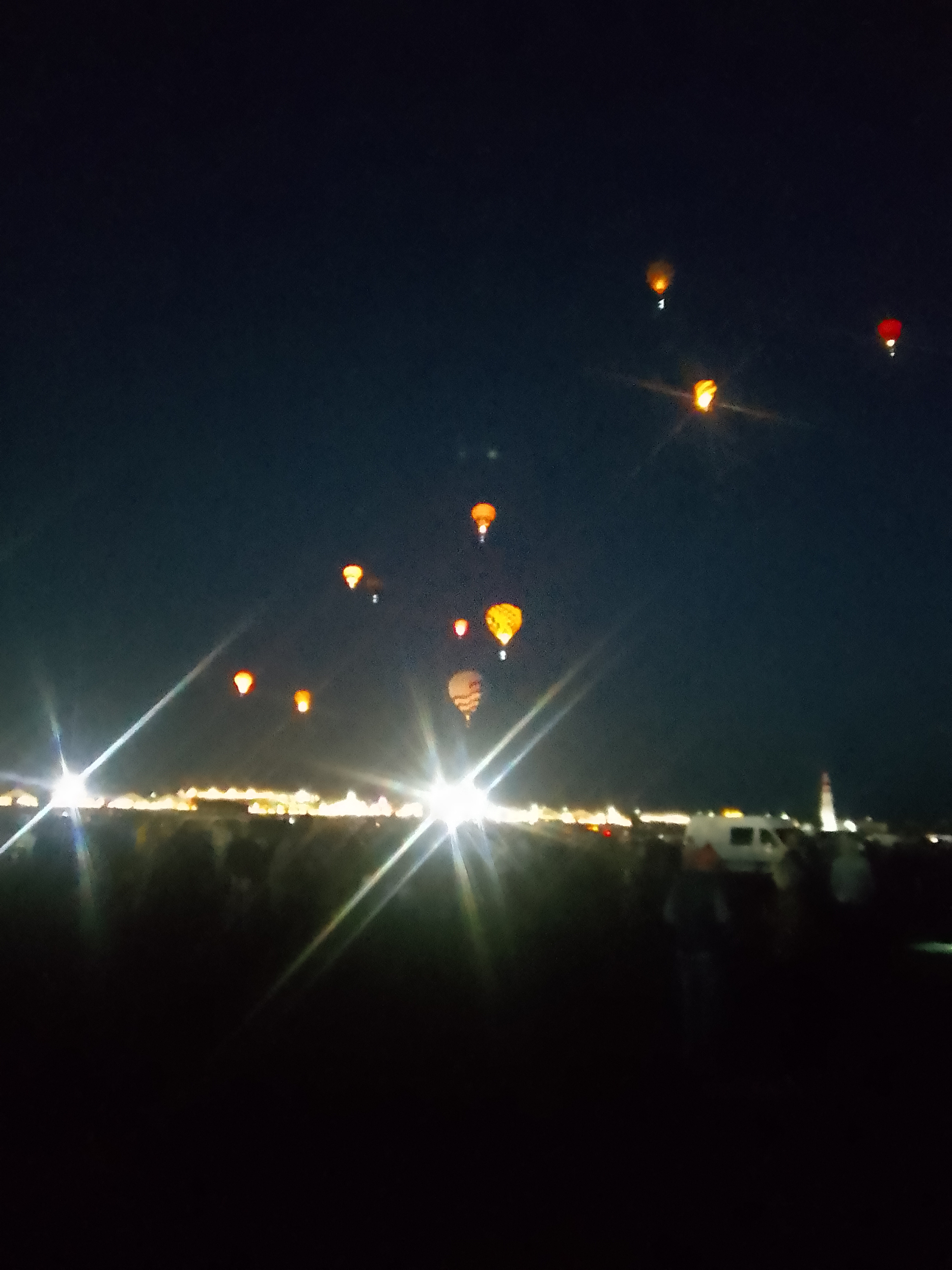
Early in 2001, I established an anonymous aviation incident reporting system for South Africans. The idea was to allow individuals to report aviation hazards anonymously, without fear of humiliation or prosecution. Unfortunately, I got no cooperation in advertising this service through CAA channels, as they were planning to introduce their own equivalent system eventually. And here I thought we were all trying to work together towards aviation safety!
Here are some of my personal highs and lows:
I'm building a collection of useful reference materials for flight training. It will grow with time, but for the moment there are already a few useful items. Let me know if you have more ideas or material.
Oh! I have slipped the surly bonds of earth,
And danced the skies on laughter-silvered wings;
Sunward I've climbed, and joined the tumbling mirth
Of sun-split clouds--and done a hundred things
You have not dreamt of--wheeled and soared and swung
High in the sunlit silence.
Hovering there,
I've chased the shouting wind along, and flung
My eager craft through footless halls of air.
Up, up the long, delirious burning blue
I've topped the wind-swept heights with easy grace,
Where never lark, or even eagle flew;
And, while with silent, lifting mind I've trod
The high untrespassed sanctity of space,
Put out my hand, and touched the face of God.
John Gillespie Magee, written in a Spitfire over wartime Britain. He was apparently the first American to be killed in the Second World War.
Return to Chris R. Burger's Home Page